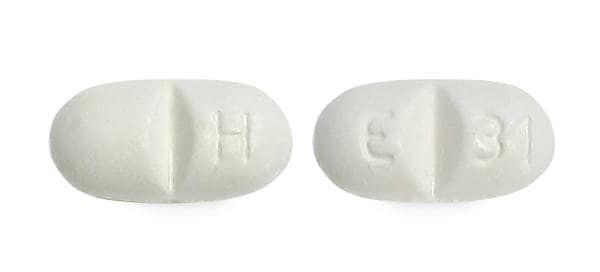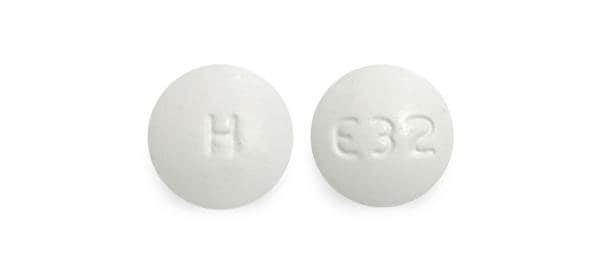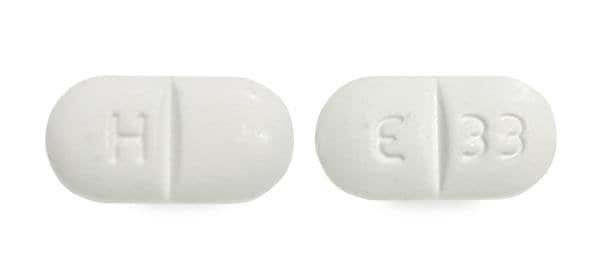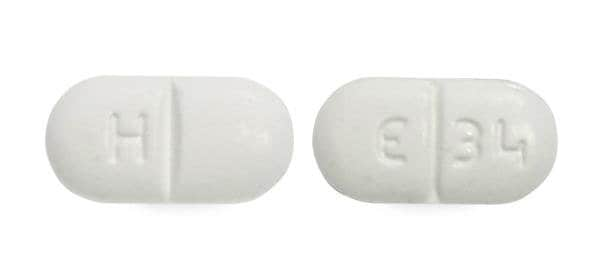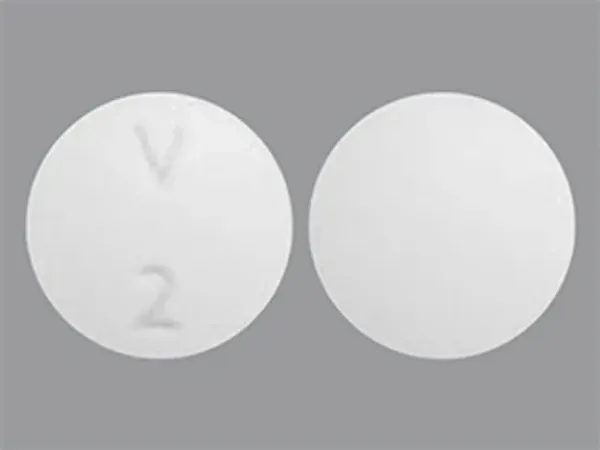Dosage Forms
Excipient information presented when available (limited, particularly for generics); consult specific product labeling.
Tablet, Oral:
Aptiom: 200 mg [scored]
Aptiom: 400 mg
Aptiom: 600 mg, 800 mg [scored]
Pharmacology
Mechanism of Action
Eslicarbazepine acetate is extensively converted to eslicarbazepine, which is considered responsible for therapeutic effects. A precise mechanism has not been defined, but is thought to involve inhibition of voltage-gated sodium channels.
Pharmacokinetics/Pharmacodynamics
Distribution
Vd: 0.87 L/kg
Metabolism
Rapidly and extensively metabolized by hydrolytic first-pass metabolism to the major active metabolite eslicarbazepine and minor active metabolites (R)-licarbazepine and oxcarbazepine; active metabolites are further metabolized to inactive glucuronides.
Excretion
Urine (90%; ~66% eslicarbazepine, ~33% glucuronide conjugate forms, ~10% other minor metabolites)
Time to Peak
Eslicarbazepine: Pediatric patients 4 to 17 years: 1 to 3 hours; Adults: 1 to 4 hours
Half-Life Elimination
Pediatric patients 4 to 17 years: 10 to 16 hours; Adults: 13 to 20 hours
Protein Binding
<40%
Use in Specific Populations
Special Populations: Renal Function Impairment
Following a single 800 mg dose, systemic exposure was increased by 62% with mild renal impairment (CrCl 50 to 80 mL/minute), 2-fold with moderate renal impairment (CrCl 30 to 49 mL/minute), and 2.5-fold with severe renal impairment (CrCl <30 mL/minute).
Use: Labeled Indications
Partial-onset seizures (epilepsy): Monotherapy or adjunctive therapy in the treatment of partial-onset seizures in adults and pediatric patients ≥4 years of age
Contraindications
Hypersensitivity to eslicarbazepine, oxcarbazepine, or any component of the formulation
Canadian labeling: Additional contraindications (not in US labeling): Hypersensitivity to carbamazepine; history of, or presence of, second- or third-degree atrioventricular block
Dosage and Administration
Dosing: Adult
Partial-onset seizures (epilepsy):
Monotherapy: Oral: Initial: 400 mg once daily; may initiate treatment at 800 mg once daily if seizure reduction outweighs risk of adverse reactions during initiation. Increase in weekly increments of 400 mg to 600 mg based on clinical response and tolerability. Maintenance: 800 mg to 1,600 mg once daily. Note: Consider 800 mg once daily for maintenance therapy in patients not tolerating 1,200 mg once daily.
Adjunctive therapy: Oral: Initial: 400 mg once daily; may initiate treatment at 800 mg once daily if seizure reduction outweighs risk of adverse reactions during initiation. Increase in weekly increments of 400 mg to 600 mg, based on clinical response and tolerability. Maintenance: 800 mg to 1,600 mg once daily. Note: Consider 1,600 mg once daily for maintenance therapy in patients not achieving response on 1,200 mg daily dosage.
Dosage adjustment with concomitant antiepileptic drugs (AEDs):
Adjunctive therapy:
Carbamazepine: Dose adjustment of eslicarbazepine or carbamazepine may be needed based on efficacy or tolerability.
Other enzyme-inducing antiepileptic drugs (eg, phenobarbital, phenytoin, primidone): Dosage of eslicarbazepine may need to be increased.
Oxcarbazepine: Concomitant use is not recommended.
Dosing: Pediatric
Seizures, partial-onset (monotherapy or adjunctive):
Children ≥4 years and Adolescents ≤17 years: Oral:
11 to 21 kg: Initial: 200 mg once daily; may increase in weekly increments of no more than 200 mg/day, titrate based on clinical response and tolerability; maintenance dose: 400 to 600 mg once daily; maximum daily dose: 600 mg/day
22 to 31 kg: Initial: 300 mg once daily; may increase in weekly increments of no more than 300 mg/day, titrate based on clinical response and tolerability; maintenance dose: 500 to 800 mg once daily; maximum daily dose: 800 mg/day
32 to 38 kg: Initial: 300 mg once daily; may increase in weekly increments of no more than 300 mg/day, titrate based on clinical response and tolerability; maintenance dose: 600 to 900 mg once daily; maximum daily dose: 900 mg/day
>38 kg: Initial: 400 mg once daily; may increase in weekly increments of no more than 400 mg/day, titrate based on clinical response and tolerability; maintenance dose: 800 to 1,200 mg once daily; maximum daily dose: 1,200 mg/day
Adolescents ≥18 years: Oral: Initial: 400 mg once daily, may initiate at 800 mg once daily if seizure reduction outweighs risk of adverse reactions during initiation. May increase in weekly increments of 400 to 600 mg/day, titrate dose based on clinical response and tolerability; maintenance dose: 800 to 1,600 mg once daily; maximum dose: 1,600 mg/day.
Dosage adjustment with concomitant antiepileptic drugs (AEDs): Children ≥4 years and Adolescents: Adjunctive therapy:
Carbamazepine: Dose adjustment of eslicarbazepine or carbamazepine may be needed based on efficacy and tolerability.
Other enzyme-inducing antiepileptic drugs (eg, phenobarbital, phenytoin, primidone): Dosage of eslicarbazepine may need to be increased.
Oxcarbazepine: Concomitant use is not recommended.
Administration
Administer with or without food; tablets may be swallowed whole or crushed.
Storage
Store at 20°C to 25°C (68°F to 77°F); excursions are permitted between 15°C and 30°C (59°F and 86°F).
Eslicarbazepine Images
Drug Interactions
Abemaciclib: CYP3A4 Inducers (Moderate) may decrease the serum concentration of Abemaciclib. Avoid combination
Antihepaciviral Combination Products: CYP3A4 Inducers (Moderate) may decrease the serum concentration of Antihepaciviral Combination Products. Avoid combination
Asunaprevir: CYP3A4 Inducers (Moderate) may decrease the serum concentration of Asunaprevir. Avoid combination
Avapritinib: CYP3A4 Inducers (Moderate) may decrease the serum concentration of Avapritinib. Avoid combination
Axitinib: CYP3A4 Inducers (Moderate) may decrease the serum concentration of Axitinib. Avoid combination
Bedaquiline: CYP3A4 Inducers (Moderate) may decrease the serum concentration of Bedaquiline. Avoid combination
Benzhydrocodone: CYP3A4 Inducers (Moderate) may decrease the serum concentration of Benzhydrocodone. Specifically, the serum concentrations of hydrocodone may be reduced. Monitor therapy
Bosutinib: CYP3A4 Inducers (Moderate) may decrease the serum concentration of Bosutinib. Avoid combination
Brigatinib: CYP3A4 Inducers (Moderate) may decrease the serum concentration of Brigatinib. Management: Avoid concurrent use of brigatinib with moderate CYP3A4 inducers when possible. If combined, increase the daily dose of brigatinib in 30 mg increments after 7 days of treatment with the current brigatinib dose, up to maximum of twice the dose. Consider therapy modification
CarBAMazepine: May enhance the adverse/toxic effect of Eslicarbazepine. CarBAMazepine may decrease the serum concentration of Eslicarbazepine. Monitor therapy
Cladribine: BCRP/ABCG2 Inducers may decrease the serum concentration of Cladribine. Monitor therapy
Clarithromycin: CYP3A4 Inducers (Moderate) may increase serum concentrations of the active metabolite(s) of Clarithromycin. CYP3A4 Inducers (Moderate) may decrease the serum concentration of Clarithromycin. Management: Consider alternative antimicrobial therapy for patients receiving a CYP3A inducer. Drugs that enhance the metabolism of clarithromycin into 14-hydroxyclarithromycin may alter the clinical activity of clarithromycin and impair its efficacy. Consider therapy modification
CloZAPine: CYP3A4 Inducers (Moderate) may decrease the serum concentration of CloZAPine. Monitor therapy
Cobimetinib: CYP3A4 Inducers (Moderate) may decrease the serum concentration of Cobimetinib. Avoid combination
Codeine: CYP3A4 Inducers (Moderate) may decrease serum concentrations of the active metabolite(s) of Codeine. Monitor therapy
CYP3A4 Substrates (High risk with Inducers): CYP3A4 Inducers (Moderate) may decrease the serum concentration of CYP3A4 Substrates (High risk with Inducers). Exceptions: Apixaban; Rivaroxaban. Monitor therapy
Daclatasvir: CYP3A4 Inducers (Moderate) may decrease the serum concentration of Daclatasvir. Management: Increase the daclatasvir dose to 90 mg once daily if used with a moderate CYP3A4 inducer. Consider therapy modification
Dasabuvir: CYP3A4 Inducers (Moderate) may decrease the serum concentration of Dasabuvir. Avoid combination
Deflazacort: CYP3A4 Inducers (Moderate) may decrease serum concentrations of the active metabolite(s) of Deflazacort. Avoid combination
Doravirine: CYP3A4 Inducers (Moderate) may decrease the serum concentration of Doravirine. Monitor therapy
Elbasvir: CYP3A4 Inducers (Moderate) may decrease the serum concentration of Elbasvir. Avoid combination
Elexacaftor, Tezacaftor, and Ivacaftor: CYP3A4 Inducers (Moderate) may decrease the serum concentration of Elexacaftor, Tezacaftor, and Ivacaftor. Monitor therapy
Encorafenib: CYP3A4 Inducers (Moderate) may decrease the serum concentration of Encorafenib. Avoid combination
Entrectinib: CYP3A4 Inducers (Moderate) may decrease the serum concentration of Entrectinib. Avoid combination
Erdafitinib: CYP3A4 Inducers (Moderate) may decrease the serum concentration of Erdafitinib. Management: Dose modifications of erdafitinib may be required. See full monograph for details. Consider therapy modification
Estriol (Systemic): CYP3A4 Inducers (Moderate) may decrease the serum concentration of Estriol (Systemic). Monitor therapy
Estriol (Topical): CYP3A4 Inducers (Moderate) may decrease the serum concentration of Estriol (Topical). Monitor therapy
Estrogen Derivatives (Contraceptive): Eslicarbazepine may decrease the serum concentration of Estrogen Derivatives (Contraceptive). Management: Alternative non-hormonal means of birth control should be considered for women of child-bearing potential. Consider therapy modification
Fedratinib: CYP3A4 Inducers (Moderate) may decrease the serum concentration of Fedratinib. Avoid combination
FentaNYL: CYP3A4 Inducers (Moderate) may decrease the serum concentration of FentaNYL. Monitor therapy
Flibanserin: CYP3A4 Inducers (Moderate) may decrease the serum concentration of Flibanserin. Avoid combination
Fosphenytoin: May decrease the serum concentration of Eslicarbazepine. (based on studies with phenytoin) Eslicarbazepine may increase the serum concentration of Fosphenytoin. (based on studies with phenytoin) Monitor therapy
Glecaprevir and Pibrentasvir: CYP3A4 Inducers (Moderate) may decrease the serum concentration of Glecaprevir and Pibrentasvir. Monitor therapy
Grazoprevir: CYP3A4 Inducers (Moderate) may decrease the serum concentration of Grazoprevir. Avoid combination
GuanFACINE: CYP3A4 Inducers (Moderate) may decrease the serum concentration of GuanFACINE. Management: Increase the guanfacine dose by up to double when initiating guanfacine in a patient taking a moderate CYP3A4 inducer. Increase guanfacine dose gradually over 1 to 2 weeks if initiating a moderate CYP3A4 inducer in a patient already taking guanfacine. Consider therapy modification
HYDROcodone: CYP3A4 Inducers (Moderate) may decrease the serum concentration of HYDROcodone. Monitor therapy
Ibrutinib: CYP3A4 Inducers (Moderate) may decrease the serum concentration of Ibrutinib. Monitor therapy
Ifosfamide: CYP3A4 Inducers (Moderate) may decrease serum concentrations of the active metabolite(s) of Ifosfamide. CYP3A4 Inducers (Moderate) may increase serum concentrations of the active metabolite(s) of Ifosfamide. Monitor therapy
Istradefylline: CYP3A4 Inducers (Moderate) may decrease the serum concentration of Istradefylline. Monitor therapy
Ivacaftor: CYP3A4 Inducers (Moderate) may decrease the serum concentration of Ivacaftor. Monitor therapy
Lacosamide: Antiepileptic Agents (Sodium Channel Blockers) may enhance the adverse/toxic effect of Lacosamide. Specifically the risk for bradycardia, ventricular tachyarrhythmias, or a prolonged PR interval may be increased. Monitor therapy
Lefamulin: CYP3A4 Inducers (Moderate) may decrease the serum concentration of Lefamulin. Management: Avoid concomitant use of lefamulin with moderate CYP3A4 inducers unless the benefits outweigh the risks. Consider therapy modification
Lefamulin (Intravenous): CYP3A4 Inducers (Moderate) may decrease the serum concentration of Lefamulin (Intravenous). Management: Avoid concomitant use of lefamulin (intravenous) with moderate CYP3A4 inducers unless the benefits outweigh the risks. Consider therapy modification
Lemborexant: CYP3A4 Inducers (Moderate) may decrease the serum concentration of Lemborexant. Avoid combination
Lorlatinib: CYP3A4 Inducers (Moderate) may enhance the hepatotoxic effect of Lorlatinib. CYP3A4 Inducers (Moderate) may decrease the serum concentration of Lorlatinib. Management: Avoid use of lorlatinib with moderate CYP3A4 inducers. If such a combination must be used, monitor AST, ALT, and bilirubin within 48 hours of starting the combination and at least three times within the first week of combined use. Consider therapy modification
Lumacaftor and Ivacaftor: CYP3A4 Inducers (Moderate) may decrease the serum concentration of Lumacaftor and Ivacaftor. Monitor therapy
Lumateperone: CYP3A4 Inducers (Moderate) may decrease the serum concentration of Lumateperone. Avoid combination
Lurasidone: CYP3A4 Inducers (Moderate) may decrease the serum concentration of Lurasidone. Management: Monitor for decreased lurasidone effects if combined with moderate CYP3A4 inducers and consider increasing the lurasidone dose if coadministered with a moderate CYP3A4 inducer for 7 or more days. Consider therapy modification
Mefloquine: May diminish the therapeutic effect of Anticonvulsants. Mefloquine may decrease the serum concentration of Anticonvulsants. Management: Mefloquine is contraindicated for malaria prophylaxis in persons with a history of convulsions. Monitor anticonvulsant concentrations and treatment response closely with concurrent use. Consider therapy modification
Meperidine: CYP3A4 Inducers (Moderate) may decrease the serum concentration of Meperidine. Monitor therapy
Mianserin: May diminish the therapeutic effect of Anticonvulsants. Monitor therapy
Mirodenafil: CYP3A4 Inducers (Moderate) may decrease the serum concentration of Mirodenafil. Monitor therapy
Naldemedine: CYP3A4 Inducers (Moderate) may decrease the serum concentration of Naldemedine. Monitor therapy
Neratinib: CYP3A4 Inducers (Moderate) may decrease the serum concentration of Neratinib. Avoid combination
NiMODipine: CYP3A4 Inducers (Moderate) may decrease the serum concentration of NiMODipine. Monitor therapy
Nisoldipine: CYP3A4 Inducers (Moderate) may decrease the serum concentration of Nisoldipine. Avoid combination
Olaparib: CYP3A4 Inducers (Moderate) may decrease the serum concentration of Olaparib. Avoid combination
Orlistat: May decrease the serum concentration of Anticonvulsants. Monitor therapy
OXcarbazepine: Eslicarbazepine may enhance the adverse/toxic effect of OXcarbazepine. Avoid combination
Palbociclib: CYP3A4 Inducers (Moderate) may decrease the serum concentration of Palbociclib. Management: The US label does not provide specific recommendations concerning use with moderate CYP3A4 inducers, but the Canadian label recommends avoiding use of moderate CYP3A4 inducers. Consider therapy modification
Perampanel: CYP3A4 Inducers (Moderate) may decrease the serum concentration of Perampanel. Management: Increase the perampanel starting dose to 4 mg/day when perampanel is used concurrently with moderate and strong CYP3A4 inducers. Consider therapy modification
Pexidartinib: CYP3A4 Inducers (Moderate) may decrease the serum concentration of Pexidartinib. Monitor therapy
PHENobarbital: May decrease the serum concentration of Eslicarbazepine. Monitor therapy
Phenytoin: May decrease the serum concentration of Eslicarbazepine. Eslicarbazepine may increase the serum concentration of Phenytoin. Monitor therapy
Pimavanserin: CYP3A4 Inducers (Moderate) may decrease the serum concentration of Pimavanserin. Avoid combination
Pitolisant: CYP3A4 Inducers (Moderate) may decrease the serum concentration of Pitolisant. Monitor therapy
Pretomanid: CYP3A4 Inducers (Moderate) may decrease the serum concentration of Pretomanid. Avoid combination
Primidone: May decrease the serum concentration of Eslicarbazepine. (based on studies with phenobarbital) Monitor therapy
Progestins (Contraceptive): Eslicarbazepine may decrease the serum concentration of Progestins (Contraceptive). Management: Alternative, non-hormonal means of birth control should be considered for women of child-bearing potential. Consider therapy modification
Ranolazine: CYP3A4 Inducers (Moderate) may decrease the serum concentration of Ranolazine. Avoid combination
Rolapitant: CYP3A4 Inducers (Moderate) may decrease the serum concentration of Rolapitant. Monitor therapy
Rosuvastatin: Eslicarbazepine may decrease the serum concentration of Rosuvastatin. Monitor therapy
Simeprevir: CYP3A4 Inducers (Moderate) may decrease the serum concentration of Simeprevir. Avoid combination
Simvastatin: Eslicarbazepine may decrease the serum concentration of Simvastatin. Monitor therapy
Sonidegib: CYP3A4 Inducers (Moderate) may decrease the serum concentration of Sonidegib. Avoid combination
Tazemetostat: CYP3A4 Inducers (Moderate) may decrease the serum concentration of Tazemetostat. Avoid combination
Tezacaftor and Ivacaftor: CYP3A4 Inducers (Moderate) may decrease the serum concentration of Tezacaftor and Ivacaftor. Monitor therapy
Ubrogepant: CYP3A4 Inducers (Moderate) may decrease the serum concentration of Ubrogepant. Management: Use an initial ubrogepant dose of 100 mg and second dose (if needed) of 100 mg when used with a moderate CYP3A4 inducer. Consider therapy modification
Upadacitinib: CYP3A4 Inducers (Moderate) may decrease the serum concentration of Upadacitinib. Monitor therapy
Velpatasvir: CYP3A4 Inducers (Moderate) may decrease the serum concentration of Velpatasvir. Avoid combination
Venetoclax: CYP3A4 Inducers (Moderate) may decrease the serum concentration of Venetoclax. Avoid combination
Voxelotor: CYP3A4 Inducers (Moderate) may decrease the serum concentration of Voxelotor. Management: Avoid concomitant use of voxelotor and moderate CYP3A4 inducers. If concomitant use is unavoidable, increase the voxelotor dose to 2,500 mg once daily. Consider therapy modification
Warfarin: Eslicarbazepine may decrease the serum concentration of Warfarin. Specifically, S-warfarin serum concentrations may be decreased. Monitor therapy
Zanubrutinib: CYP3A4 Inducers (Moderate) may decrease the serum concentration of Zanubrutinib. Avoid combination
Zolpidem: CYP3A4 Inducers (Moderate) may decrease the serum concentration of Zolpidem. Monitor therapy
Adverse Reactions
>10%:
Central nervous system: Dizziness (20% to 28%), drowsiness (11% to 28%), headache (13% to 15%)
Gastrointestinal: Nausea (10% to 16%)
Ophthalmic: Diplopia (9% to 11%)
1% to 10%:
Cardiovascular: Hypertension (2%), peripheral edema (2%)
Central nervous system: Fatigue (7%), cognitive dysfunction (4% to 7%), ataxia (4% to 6%), vertigo (2% to 6%), depression (3%), equilibrium disturbance (3%), falling (3%), abnormal gait (2%), insomnia (2%), dysarthria (1% to 2%), memory impairment (1% to 2%)
Dermatologic: Skin rash (3%)
Endocrine & metabolic: Hyponatremia (serum sodium <125 mEq/L: 1% to 2%)
Gastrointestinal: Vomiting (6% to 10%), diarrhea (4%), abdominal pain (2%), constipation (2%), gastritis (2%)
Genitourinary: Urinary tract infection (2%)
Neuromuscular & skeletal: Tremor (2% to 4%), weakness (3%)
Ophthalmic: Blurred vision (5% to 6%), decreased visual acuity (2%), nystagmus (1% to 2%)
Respiratory: Cough (2%)
Frequency not defined:
Endocrine & metabolic: Hypercholesterolemia, hypochloremia (concurrent with hyponatremia), increased LDL cholesterol, increased serum triglycerides
Hematologic & oncologic: Decreased hematocrit, decreased hemoglobin
Neuromuscular & skeletal: Increased creatine phosphokinase
<1%, postmarketing, and/or case reports: Agranulocytosis, anaphylaxis, angioedema, decreased T3 level, decreased T4 (free and total), DRESS syndrome, increased serum bilirubin (>2 x ULN), increased serum transaminases (>3 x ULN), leukopenia, megaloblastic anemia, pancytopenia, prolongation P-R interval on ECG (mild [Vas-Da-Silva 2012]), severe dermatological reaction, SIADH, Stevens-Johnson syndrome, thrombocytopenia, toxic epidermal necrolysis
Warnings/Precautions
Concerns related to adverse effects:
- CNS effects: Use has been associated with dose-dependent CNS-related adverse events, most significant of these were cognitive symptoms (eg, memory impairment, disturbance in attention, amnesia, confusional state, aphasia, speech disorder, slowness of thought, disorientation, psychomotor retardation), somnolence or fatigue, dizziness and coordination abnormalities (eg, ataxia, vertigo, balance disorder, gait disturbance, nystagmus, abnormal coordination), and visual changes (eg, diplopia, blurred vision, impaired vision). There was an increased risk of visual changes and dizziness and coordination abnormalities during the titration period, in patients >60 years of age, and with concomitant carbamazepine use; consider dosage modifications in patients using eslicarbazepine and carbamazepine concomitantly. Caution patients about performing tasks which require mental alertness (eg, operating machinery or driving).
- Dermatologic reactions: Potentially serious, sometimes fatal, dermatologic reactions including Stevens-Johnson syndrome (SJS) have been reported; monitor for signs and symptoms of skin reactions; discontinuation and conversion to alternate therapy may be required. Avoid use in patients with prior dermatologic reaction with carbamazepine, oxcarbazepine, or eslicarbazepine.
- Hematologic effects: Cases of pancytopenia, agranulocytosis, and leukopenia have been reported; consider discontinuing eslicarbazepine if these hematologic abnormalities develop.
- Hepatic effects: Hepatic effects ranging from mild to moderate elevations in transaminases (>3 times the upper limit of normal) to rare cases of concomitant elevations of total bilirubin (>2 times the upper limit of normal) have been reported. Perform baseline liver laboratory tests. Discontinue in patients with jaundice or other evidence of significant liver injury.
- Hypersensitivity reactions: Rare cases of anaphylaxis and angioedema have been reported. Permanently discontinue should symptoms occur. Avoid use in patients with a prior anaphylactic-type reaction with either oxcarbazepine or eslicarbazepine.
- Hyponatremia: Clinically significant hyponatremia (serum sodium <125 mmol/L) and concurrent hypochloremia may develop during use. In controlled trials, effects were dose-related, appeared within the first 8 weeks of treatment (as early as after 3 days), and resolved without additional treatment within a few days of eslicarbazepine discontinuation. Consider monitoring serum sodium and chloride levels during maintenance treatment, especially in patients at risk for hyponatremia and if symptoms of hyponatremia develop. Depending on the severity of hyponatremia, the dose of eslicarbazepine may need to be reduced or discontinued.
- Multiorgan hypersensitivity reactions: Potentially serious, sometimes fatal drug reaction with eosinophilia and systemic symptoms (DRESS), also known as multiorgan hypersensitivity reactions, have been reported. Monitor for signs and symptoms (eg, fever, rash, lymphadenopathy, eosinophilia) in association with other organ system involvement (eg, hepatitis, nephritis, hematological abnormalities, myocarditis, myositis). Evaluate immediately if signs or symptoms are present. Discontinuation and conversion to alternate therapy may be required. Avoid use in patients with a prior DRESS reaction with carbamazepine, oxcarbazepine, or eslicarbazepine.
- Suicidal ideation: Pooled analysis of trials involving various antiepileptics (regardless of indication) showed an increased risk of suicidal thoughts/behavior (incidence rate: 0.43% treated patients compared to 0.24% of patients receiving placebo); risk observed as early as 1 week after initiation and continued through duration of trials (most trials ≤24 weeks). Monitor all patients for notable changes in behavior that might indicate suicidal thoughts or depression; patients should be instructed to notify healthcare provider immediately if symptoms occur.
- Thyroid function: Dose-dependent decreases in serum T3 and T4 (free and total) values have been observed; changes were not associated with other abnormal thyroid function tests suggesting hypothyroidism.
Disease-related concerns:
- Renal impairment: Clearance is decreased in patients with impaired renal function; dosage adjustment is necessary in patients with CrCl <50 mL/minute.
- Hepatic impairment: Avoid use in patients with severe hepatic impairment.
Concurrent drug therapy issues:
- Drug-drug interactions: Potentially significant interactions may exist, requiring dose or frequency adjustment, additional monitoring, and/or selection of alternative therapy. Consult drug interactions database for more detailed information.
Other warnings/precautions:
- Withdrawal: Anticonvulsants should not be discontinued abruptly because of the possibility of increasing seizure frequency; therapy should be withdrawn gradually to minimize the potential of increased seizure frequency, unless safety concerns require a more rapid withdrawal.
Monitoring Parameters
Seizure frequency; liver enzymes (baseline); serum sodium and chloride as deemed necessary during maintenance treatment, particularly in patients receiving other medications known to decrease sodium levels or if symptoms of hyponatremia develop; symptoms of CNS depression (dizziness, disturbance in gait and coordination, somnolence); visual changes; hypersensitivity reactions. Monitor for suicidality (eg, suicidal thoughts, depression, behavioral changes). For adjunctive therapy, serum levels of concomitant antiepileptic drugs during titration as necessary.
Pregnancy
Pregnancy Considerations
Adverse events have been observed in animal reproduction studies. Eslicarbazepine may decrease plasma concentrations of hormonal contraceptives; additional or alternative nonhormonal contraceptives are recommended in women of reproductive potential.
Patients exposed to eslicarbazepine during pregnancy are encouraged to enroll themselves into the North American Antiepileptic Drug (NAAED) Pregnancy Registry by calling 1-888-233-2334. Additional information is available at http://www.aedpregnancyregistry.org.
Patient Education
What is this drug used for?
- It is used to help control certain kinds of seizures.
Frequently reported side effects of this drug
- Headache
- Nausea
- Vomiting
- Fatigue
- Tremors
Other side effects of this drug: Talk with your doctor right away if you have any of these signs of:
- Infection
- Depression like thoughts of suicide, anxiety, emotional instability, or confusion.
- Low sodium like headache, trouble focusing, trouble with memory, confusion, weakness, seizures, or change in balance.
- Liver problems like dark urine, fatigue, lack of appetite, nausea, abdominal pain, light-colored stools, vomiting, or yellow skin.
- Kidney problems like unable to pass urine, blood in the urine, change in amount of urine passed, or weight gain.
- Swollen glands
- Shortness of breath
- Excessive weight gain
- Swelling of arms or legs
- Chest pain
- Severe dizziness
- Passing out
- Severe muscle pain
- Severe muscle weakness
- Severe loss of strength and energy
- Vision changes
- Seizures
- Bruising
- Bleeding
- Chills
- Involuntary eye movements
- Trouble walking
- Agitation
- Irritability
- Panic attacks
- Mood changes
- Stevens-Johnson syndrome/toxic epidermal necrolysis like red, swollen, blistered, or peeling skin (with or without fever); red or irritated eyes; or sores in mouth, throat, nose, or eyes.
- Signs of a significant reaction like wheezing; chest tightness; fever; itching; bad cough; blue skin color; seizures; or swelling of face, lips, tongue, or throat.
Note: This is not a comprehensive list of all side effects. Talk to your doctor if you have questions.
Consumer Information Use and Disclaimer: This information should not be used to decide whether or not to take this medicine or any other medicine. Only the healthcare provider has the knowledge and training to decide which medicines are right for a specific patient. This information does not endorse any medicine as safe, effective, or approved for treating any patient or health condition. This is only a brief summary of general information about this medicine. It does NOT include all information about the possible uses, directions, warnings, precautions, interactions, adverse effects, or risks that may apply to this medicine. This information is not specific medical advice and does not replace information you receive from the healthcare provider. You must talk with the healthcare provider for complete information about the risks and benefits of using this medicine.
